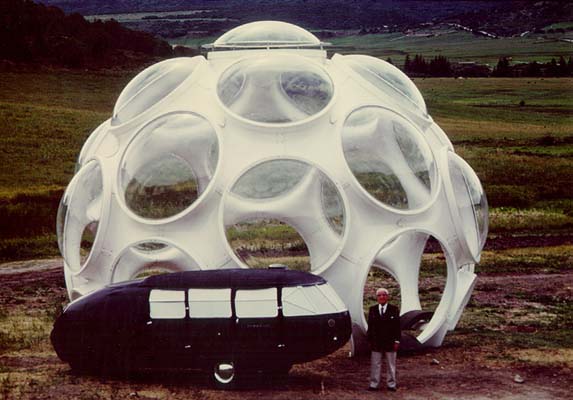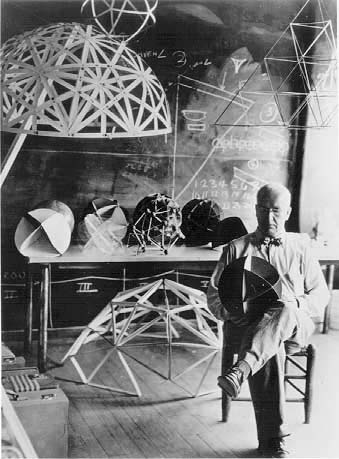|
Born: 12 July 1895 in Milton, Massachusetts, USA
R Buckminster Fuller was referred to as an architect, inventor, scientist, engineer, mathematician, educator, philosopher, poet, speaker, author, consultant, economist, futurist, transcendentalist, designer. Twice expelled from Harvard University, he received 47 honorary doctorates in the arts, science, engineering and the humanities. He examined a vectorial system of geometry, energetic-synergetic geometry, based on the tetrahedron which provides maximum strength with minimum structure.
Fuller spent a few summers in the late forties and early fifties teaching at the Black Mountain College. He was research professor at Carbondale, Southern Illinois University, from 1959 to 1968. In 1968 he became a university professor and retired in 1975. He was awarded 25 U.S. patents; authored 28 books; received dozens of major architectural and design awards including, among many others, the Gold Medal of the American Institute of Architects and the Gold Medal of the Royal Institute of British Architects created work which found itself into the permanent collections of museums around the world circled the globe 57 times, reaching millions through his public lectures and interviews.
Buckminster Fuller is best known for the invention of the geodesic dome –the lightest, strongest, and most cost-effective structure ever devised. The geodesic dome is a breakthrough in shelter, not only in cost-effectiveness, but in ease of construction. Today over 300,000 domes dot the globe. Plastic and fiberglass "radomes" house delicate radar equipment along the Arctic perimeter, and "radome" weather stations withstand winds up to 180 mph. Corrugated metal domes have given shelter to families in Africa, at a cost of $350 per dome. The U.S. Marine Corps hailed the geodesic dome as "the first basic improvement in mobile military shelter in 2,600 years". The world’s largest aluminum clear-span structure is a geodesic dome which houses the "Spruce Goose" at Long Beach Harbor. Fuller is most famous for his 20-story dome housing the U.S. Pavilion at Montreal’s Expo ?7. Later, he documented the feasibility of a dome two miles in diameter that would enclose mid-town Manhattan in a temperature-controlled environment, and pay for itself within ten years from the savings of snow-removal costs.
Fuller originated the term "Spaceship Earth". His Dymaxion™ Map was awarded the first patent for a cartographic system and was the first to show continents on a flat surface without visible distortion, appearing as a one-world island in a one-world ocean. His World Game® utilizes a large-scale Dymaxion Map for displaying world resources, and allows players to strategize solutions to global problems, matching human needs with resources. His Inventory of World Resources, Human Trends and Needs was created to serve as an information bank for the World Game.
Throughout the 1940s and 1950s, Fuller gained a formidable reputation as an early researcher of renewable energy sources. Drawing upon US Navy experiences, Fuller developed tensegrity structures, notably the Geodesic Dome (minimalist structures that actually get stronger as they get larger). He also discovered the science of Synergetics, which explores holistic engineering structures in nature (long before the term synergy became popular). Famous Geodesic Domes include The EPCOT Center at Florida's Walt Disney World and the US Pavilion at the 1967 Montreal World's Fair.
Fuller believed that any true social or political revolution must arise from and encompass design revolution insights, and not just be based upon shallow political rhetoric. Beginning in the 1930s initiatives like the Dymaxion World Map (which gives more accurate representations than traditional maps), the Global Energy Network grid and World Game geostrategic scenarios were promoted by the State of the World Forum and futurists including Robert Anton Wilson, Barbara Marx Hubbard and Marshall Savage.
Books like Operating Manual for Spaceship Earth (New York: Simon & Schuster, 1969) and Critical Path (New York: St. Martin's Press, 1982) captured a wide audience. These books (and many others) featured systems theory principles, laying the groundwork for Alvin Toffler, Tom Peters, John Naisbitt and Peter Senge. The Spaceship Earth meme became popular with the awakening of Gaia-consciousness, and the Overview Effect experienced by astronauts and cosmonauts.
Fuller's twenty-eight books explore how 100% of humanity could have high living standards - have sold over a million copies. His efforts were recognised by over fifty honorary degrees in the sciences and humanities, and receiving the Presidential Medal of Freedom from Ronald Reagan in 1981.
Since Fuller's death in 1983, a diverse network has continued to research and apply Buckminster Fuller's work to diverse areas. This network generates new scenarios and options for humanity's survival in the Cosmos.
|

